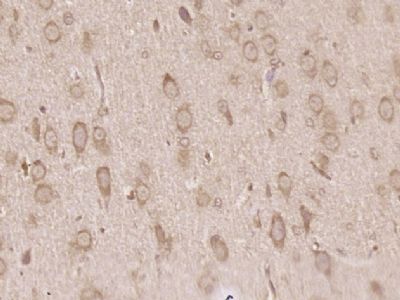产品货号 : mlR20500
英文名称 : KAT13D/CLOCK
中文名称 : 生物钟KAT13D蛋白抗体
别 名 : Circadian locomoter output cycles kaput protein; Circadian Locomotor Output Cycles Kaput; Circadian Locomotor Output Cycles Kaput; Circadium Locomotor Output Cycles Kaput; Circadium Locomotor Output Cycles Kaput; Clock homolog; Clock protein; hCLOCK; KIAA0334; CLOCK_HUMAN.
研究领域 : 心血管 细胞生物 神经生物学 信号转导 表观遗传学
抗体来源 : Rabbit
克隆类型 : Polyclonal
交叉反应 : Human, Mouse, Rat, Cow, Horse, Rabbit, Sheep,
产品应用 : ELISA=1:500-1000 IHC-P=1:400-800 IHC-F=1:400-800 ICC=1:100-500 IF=1:100-500 (石蜡切片需做抗原修复)
not yet tested in other applications.
optimal dilutions/concentrations should be determined by the end user.
分 子 量 : 95kDa
细胞定位 : 细胞核 细胞浆
性 状 : Lyophilized or Liquid
浓 度 : 1mg/ml
免 疫 原 : KLH conjugated synthetic peptide derived from human KAT13D/CLOCK:201-300/846
亚 型 : IgG
纯化方法 : affinity purified by Protein A
储 存 液 : Preservative: 15mM Sodium Azide, Constituents: 1% BSA, 0.01M PBS, pH 7.4
保存条件 : Store at -20 °C for one year. Avoid repeated freeze/thaw cycles. The lyophilized antibody is stable at room temperature for at least one month and for greater than a year when kept at -20°C. When reconstituted in sterile pH 7.4 0.01M PBS or diluent of antibody the antibody is stable for at least two weeks at 2-4 °C.
PubMed : PubMed
产品介绍background:
This gene product regulates circadian rhythm and metabolism. The protein encodes a transcription factor of the basic helix-loop-helix (bHLH) family and a DNA binding histone acetyltransferase. Polymorphisms in this gene may be associated with behavioral changes in certain populations and with obesity and metabolic syndrome. Alternative splicing results in multiple transcript variants.
Function:
ARNTL/2-CLOCK heterodimers activate E-box element (3'-CACGTG-5') transcription of a number of proteins of the circadian clock. Activates transcription of PER1 and PER2. This transcription is inhibited in a feedback loop by PER and CRY proteins. Has intrinsic histone acetyltransferase activity and this enzymatic function contributes to chromatin-remodeling events implicated in circadian control of gene expression (By similarity). Acetylates primarily histones H3 and H4 (By similarity). Acetylates also a non-histone substrate: ARNTL.
Subunit:
Component of the circadian clock oscillator which includes the CRY proteins, CLOCK or NPAS2, ARNTL or ARNTL2, CSNK1D and/or CSNK1E, TIMELESS and the PER proteins. Efficient DNA binding requires dimerization with another bHLH protein. Heterodimerization with ARNTL is required for E-box-dependent transactivation, for CLOCK nuclear translocation and degradation, and, for phosphorylation of both CLOCK and ARNTL. Interaction with PER and CRY proteins requires translocation to the nucleus. Interaction of the CLOCK-ARNTL heterodimer with PER or CRY inhibits transcription activation. Binds weakly ARNTL and ARNTL2 to form heterodimers which bind poorly to the E-box motif
Subcellular Location:
Cytoplasm. Nucleus. Shuffling between the cytoplasm and the nucleus is under circadian regulation and is ARNTL-dependent. Phosphorylated form located in the nucleus.
Tissue Specificity:
Expressed in all tissues examined including spleen, thymus, prostate, testis, ovary, small intestine, colon, leukocytes, heart, brain, placenta, lung, liver, skeletal muscle, kidney and pancreas. Highest levels in testis and skeletal muscle. Low levels in thymus, lung and liver. Expressed in all brain regions with highest levels in cerebellum. Highly expressed in the suprachiasmatic nucleus (SCN).
Post-translational modifications:
Phosphorylation is dependent on CLOCK-ARNTL heterodimer formation.
Similarity:
Contains 1 basic helix-loop-helix (bHLH) domain.
Contains 1 PAC (PAS-associated C-terminal) domain.
Contains 2 PAS (PER-ARNT-SIM) domains.
SWISS:
O15516
Gene ID:
9575
Important Note:
This product as supplied is intended for research use only, not for use in human, therapeutic or diagnostic applications.
产品图片












